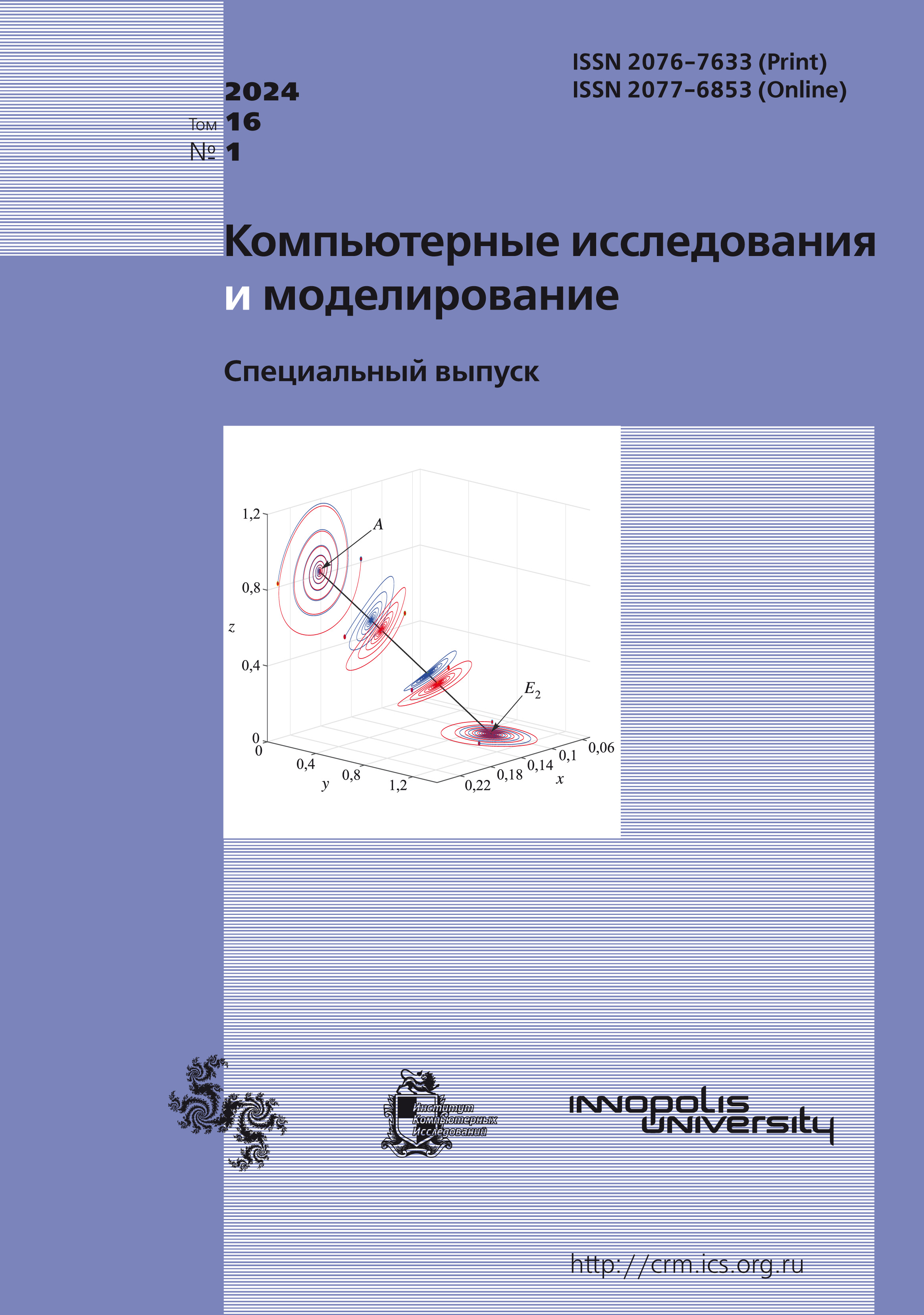All issues
- 2024 Vol. 16
- Issue 1 (special issue)
- 2023 Vol. 15
- 2022 Vol. 14
- 2021 Vol. 13
- 2020 Vol. 12
- 2019 Vol. 11
- 2018 Vol. 10
- 2017 Vol. 9
- 2016 Vol. 8
- 2015 Vol. 7
- 2014 Vol. 6
- 2013 Vol. 5
- 2012 Vol. 4
- 2011 Vol. 3
- 2010 Vol. 2
- 2009 Vol. 1
-
About quality of Kernel based object tracking
Computer Research and Modeling, 2014, v. 6, no. 4, pp. 495-502The kernel based object tracking algorithms were described that take in account the independent changes of the 4 and 5 out of 5 parameters of the elliptic tracking region. It is shown that in tracking this conditions are sufficient and attempts of prediction are not necessary.
Keywords: automatic tracking, kernel based object tracking.Views (last year): 4. Citations: 2 (RSCI). -
Neural network analysis of transportation flows of urban aglomeration using the data from public video cameras
Computer Research and Modeling, 2021, v. 13, no. 2, pp. 305-318Correct modeling of complex dynamics of urban transportation flows requires the collection of large volumes of empirical data to specify types of the modes and their identification. At the same time, setting a large number of observation posts is expensive and technically not always feasible. All this results in insufficient factographic support for the traffic control systems as well as for urban planners with the obvious consequences for the quality of their decisions. As one of the means to provide large-scale data collection at least for the qualitative situation analysis, the wide-area video cameras are used in different situation centers. There they are analyzed by human operators who are responsible for observation and control. Some video cameras provided their videos for common access, which makes them a valuable resource for transportation studies. However, there are significant problems with getting qualitative data from such cameras, which relate to the theory and practice of image processing. This study is devoted to the practical application of certain mainstream neuro-networking technologies for the estimation of essential characteristics of actual transportation flows. The problems arising in processing these data are analyzed, and their solutions are suggested. The convolution neural networks are used for tracking, and the methods for obtaining basic parameters of transportation flows from these observations are studied. The simplified neural networks are used for the preparation of training sets for the deep learning neural network YOLOv4 which is later used for the estimation of speed and density of automobile flows.
-
On quality of object tracking algorithms
Computer Research and Modeling, 2012, v. 4, no. 2, pp. 303-313Views (last year): 20. Citations: 9 (RSCI).Object movement on a video is classified on the regular (object movement on continuous trajectory) and non-regular (trajectory breaks due to object occlusions by other objects, object jumps and others). In the case of regular object movement a tracker is considered as a dynamical system that enables to use conditions of existence, uniqueness, and stability of the dynamical system solution. This condition is used as the correctness criterion of the tracking process. Also, quantitative criterion for correct mean-shift tracking assessment based on the Lipchitz condition is suggested. Results are generalized for arbitrary tracker.
-
Views (last year): 29.
Intersections present a very demanding environment for all the parties involved. Challenges arise from complex vehicle trajectories; occasional absence of lane markings to guide vehicles; split phases that prevent determining who has the right of way; invisible vehicle approaches; illegal movements; simultaneous interactions among pedestrians, bicycles and vehicles. Unsurprisingly, most demonstrations of AVs are on freeways; but the full potential of automated vehicles — personalized transit, driverless taxis, delivery vehicles — can only be realized when AVs can sense the intersection environment to efficiently and safely maneuver through intersections.
AVs are equipped with an array of on-board sensors to interpret and suitably engage with their surroundings. Advanced algorithms utilize data streams from such sensors to support the movement of autonomous vehicles through a wide range of traffic and climatic conditions. However, there exist situations, in which additional information about the upcoming traffic environment would be beneficial to better inform the vehicles’ in-built tracking and navigation algorithms. A potential source for such information is from in-pavement sensors at an intersection that can be used to differentiate between motorized and non-motorized modes and track road user movements and interactions. This type of information, in addition to signal phasing, can be provided to the AV as it approaches an intersection, and incorporated into an improved prior for the probabilistic algorithms used to classify and track movement in the AV’s field of vision.
This paper is concerned with the situation in which there are objects that are not visible to the AV. The driving context is that of an intersection, and the lack of visibility is due to other vehicles that obstruct the AV’s view, leading to the creation of blind zones. Such obstruction is commonplace in intersections.
Our objective is:
1) inform a vehicle crossing the intersection about its potential blind zones;
2) inform the vehicle about the presence of agents (other vehicles, bicyclists or pedestrians) in those blind zones.
Indexed in Scopus
Full-text version of the journal is also available on the web site of the scientific electronic library eLIBRARY.RU
The journal is included in the Russian Science Citation Index
The journal is included in the RSCI
International Interdisciplinary Conference "Mathematics. Computing. Education"





